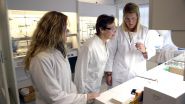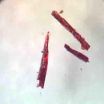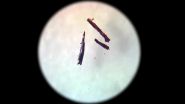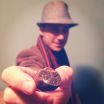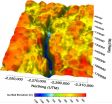(Press-News.org) Researchers from the University of Southern Denmark have synthesized crystalline materials that can bind and store oxygen in high concentrations. Just one spoon of the substance is enough to absorb all the oxygen in a room. The stored oxygen can be released again when and where it is needed.
We do fine with the 21 per cent oxygen in the air around us. But sometimes we need oxygen in higher concentrations; for example lung patients must carry heavy oxygen tanks, cars using fuel cells need a regulated oxygen supply. Perhaps one day in the future even sunlight-driven "reversible" fuel cells will be made. With these we will have to separate oxygen from hydrogen in order to recombine them in order to get energy.
Now Professor Christine McKenzie and postdoc Jonas Sundberg, Department of Physics, Chemistry and Pharmacy at the University of Southern Denmark have synthesized a material that absorb oxygen in large quantities and store it.
"In the lab, we saw how this material took up oxygen from the air around us", says Christine McKenzie.
The new material is crystalline, and using x-ray diffraction the researchers have studied the arrangement of atoms inside the material when it was filled with oxygen, and when it was emptied of oxygen.
The fact that a substance can react with oxygen is not surprising. Lots of substances do this - and the result is not always desirable: Food can go rancid when exposed to oxygen. On the other hand a wine's taste and aroma is changed subtly when we aerate it - but not with too much oxygen! Our bodies cannot function if we do not breathe.
"An important aspect of this new material is that it does not react irreversibly with oxygen - even though it absorbs oxygen in a so-called selective chemisorptive process. The material is both a sensor, and a container for oxygen - we can use it to bind, store and transport oxygen - like a solid artificial hemoglobin", says Christine McKenzie.
The material is so effective at binding oxygen, that only a spoon of it is enough to suck up all the oxygen in a room. The researchers' work indicates that the substance can absorb and bind oxygen in a concentration 160 times larger than the concentration in the air around us.
"It is also interesting that the material can absorb and release oxygen many times without losing the ability. It is like dipping a sponge in water, squeezing the water out of it and repeating the process over and over again", Christine McKenzie explains.
Once the oxygen has been absorbed you can keep it stored in the material until you want to release it. The oxygen can be released by gently heating the material or subjecting it to low oxygen pressures.
"We see release of oxygen when we heat up the material, and we have also seen it when we apply vacuum. We are now wondering if light can also be used as a trigger for the material to release oxygen – this has prospects in the growing field of artificial photosynthesis", says Christine McKenzie.
The key component of the new material is the element cobalt, which is bound in a specially designed organic molecule.
"Cobalt gives the new material precisely the molecular and electronic structure that enables it to absorb oxygen from its surroundings. This mechanism is well known from all breathing creatures on earth: Humans and many other species use iron, while other animals, like crabs and spiders, use copper. Small amounts of metals are essential for the absorption of oxygen, so actually it is not entirely surprising to see this effect in our new material", explains Christine McKenzie.
Depending on the atmospheric oxygen content, temperature, pressure, etc. it takes seconds, minutes, hours or days for the substance to absorb oxygen from its surroundings. Different versions of the substance can bind oxygen at different speeds. With this complexity it becomes possible to produce devices that release and/or absorb oxygen under different circumstances – for example a mask containing layers of these materials in the correct sequence might actively supply a person with oxygen directly from the air without the help of pumps or high pressure equipment.
"When the substance is saturated with oxygen, it can be compared to an oxygen tank containing pure oxygen under pressure - the difference is that this material can hold three times as much oxygen," says Christine McKenzie.
"This could be valuable for lung patients who today must carry heavy oxygen tanks with them. But also divers may one day be able to leave the oxygen tanks at home and instead get oxygen from this material as it "filters" and concentrates oxygen from surrounding air or water. A few grains contain enough oxygen for one breath, and as the material can absorb oxygen from the water around the diver and supply the diver with it, the diver will not need to bring more than these few grains".
INFORMATION:
The substance has been designed and synthesized at University of Southern Denmark. Some of the gas uptake measurements have been made with special equipment by colleagues at the University of Sydney, Australia.
See a film about the new material here: http://www.youtube.com/watch?v=gJbG9FvgX0U&feature=youtu.be
Contact
Professor Christine McKenzie
45-6550-2518
mckenzie@sdu.dk
Reference
Oxygen chemisorption / desorption in a reversible single-crystal-to-single-crystal transformation. Jonas Sundberg, Lisa J. Cameron, Peter D. Southon, Cameron J. Kepert and Christine J. McKenzie.
New material steals oxygen from the air
2014-09-30
ELSE PRESS RELEASES FROM THIS DATE:
Low-birth-weight children are particularly vulnerable to environmental influences
2014-09-30
Low birth weight children are more vulnerable to environmental influences than infants born with normal weight. When brought up with a great deal of sensitivity, they will be able to catch up in school, but on average they will not become better students than normal birth weight children. This result, provided by an international psychologist team, has confirmed the so-called diathesis-stress model of development for low birth weight populations. The researchers report their findings in the Journal of Child Psychology and Psychiatry.
Theories on how environmental factors ...
Genetic test would help 'cut bowel cancer spread'
2014-09-30
Screening families of patients with bowel cancer for a genetic condition would cut their risk of developing bowel, womb, and ovarian cancers, new research has found.
In a major study, Dr Ian Frayling from Cardiff University's School of Medicine and researchers from the University of Exeter's Medical School assessed the effectiveness of introducing a UK-wide screening programme for a genetic condition known as Lynch Syndrome.
Lynch syndrome is a caused by changes in genes which check the spelling in DNA. The condition increases the risk of people developing cancer, ...
Bacteria may have ability to reduce impact of diazepam on UK river environments
2014-09-30
The natural photo degradation of diazepam (valium) and similar medicines – followed by bacterial breakdown – may reduce their potentially harmful impact on the UK's freshwater environment, a team of researchers has said.
Diazepam – used to treat anxiety and other similar conditions – has been detected in rivers across the UK and Europe, having been released from waste water treatment plants. At the levels recorded, it has the potential to produce harmful ecological effects in surface waters, including changing the behaviour of fish shoals and their ability to sense danger ...
Entanglement made tangible
2014-09-30
Quantum entanglement refers to the "pairing" of two subatomic particles in such a way that they form a whole quantum system. Interest in entanglement is increasing today, as it challenges the foundations of quantum mechanics itself, and is also key for achieving quantum information processing and communication. Entanglement is thought to exist up to the everyday, or "macroscopic" realm – according to the predictions of quantum physics – but experimental proposals to show this often involve conditions that are difficult to achieve in today's labs. Publishing in Physical ...
Shape up quickly -- applies to fish, too!
2014-09-30
Fish can live in almost any aquatic environment on Earth, but when the climate changes and temperatures go up many species are pushed to the limit. The amount of time needed to adjust to new conditions could prove critical for how different species cope in the future, reveals a new study from researchers at the University of Gothenburg, published in the scientific journal Proceedings of the Royal Society B.
Climate change continues apace thanks to increasing levels of greenhouse gases in the atmosphere. The greenhouse effect has led not only to an increase in average ...
Dietary polyunsaturated fatty acids linked to smaller risk of coronary heart disease
2014-09-30
A recent study completed at the University of Eastern Finland shows that dietary polyunsaturated fatty acids may reduce the risk of coronary heart disease. The sources of polyunsaturated fatty acids include fish, vegetable oils, and nuts. The findings were published in Arteriosclerosis, Thrombosis & Vascular Biology, an esteemed journal of the American Heart Association.
Recent studies have not found an association between the consumption of saturated fats and the risk of cardiovascular diseases. It seems that the mere reduction of saturated fats from the diet does not ...
On the trail of the truffle flavor
2014-09-30
This news release is available in German. FRANKFURT. Truffles, along with caviar, are among the most expensive foods in the world. Because they grow underground, people use trained dogs or pigs to find them. But the distinctive smell of truffles is not only of interest to gourmets. A group of German and French scientists under the direction of the Goethe University Frankfurt have discovered that the smell of white truffles is largely produced by soil bacteria which are trapped inside truffle fruiting bodies.
White truffles from the Piedmont region in Italy can reach ...
NASA ocean data shows 'climate dance' of plankton
2014-09-30
The greens and blues of the ocean color from NASA satellite data have provided new insights into how climate and ecosystem processes affect the growth cycles of phytoplankton—microscopic aquatic plants important for fish populations and Earth's carbon cycle.
At the bottom of the ocean's food chain, phytoplankton account for roughly half of the net photosynthesis on Earth. Their photosynthesis consumes carbon dioxide and plays a key role in transferring carbon from the atmosphere to the ocean. Unlike the plant ecosystems on land, the amount of phytoplankton in the ocean ...
NASA support key to glacier mapping efforts
2014-09-30
Thanks in part to support from NASA and the National Science Foundation, scientists have produced the first-ever detailed maps of bedrock beneath glaciers in Greenland and Antarctica. This new data will help researchers better project future changes to glaciers and ice sheets, and ultimately, sea level.
Researchers at the Center for Remote Sensing of Ice Sheets, or CReSIS, at the University of Kansas in Lawrence, Kansas, recently built detailed maps of the terrain beneath Greenland's Jakobshavn Glacier and Byrd Glacier in Antarctica. The results of this study were published ...
NASA-funded rocket has 6 minutes to study solar heating
2014-09-30
On Sept. 30, 2014, a sounding rocket will fly up into the sky – past Earth's atmosphere that obscures certain wavelengths of light from the sun -- for a 15-minute journey to study what heats up the sun's atmosphere. This is the fourth flight for the Very high Angular Resolution Ultraviolet Telescope, or VAULT, will launch from the White Sands Missile Range near Las Cruces, New Mexico.
The instrument, now called VAULT2.0, has been refurbished with new electronics and an imaging detector to capture images more frequently than before. While in space, VAULT2.0 will observe ...
